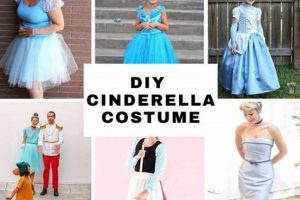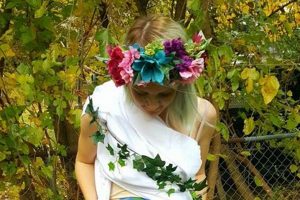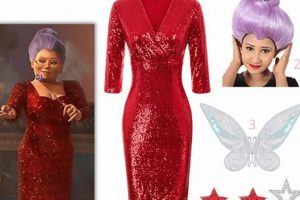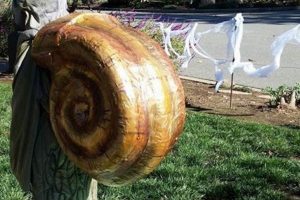Creating a Tigger costume at home is a do-it-yourself project that involves crafting an outfit replicating the appearance of the Winnie-the-Pooh character, Tigger. This endeavor typically includes constructing the character’s signature orange and black striped body, a bouncy tail, and a headpiece featuring Tigger’s distinct facial features. An example of this undertaking would be using felt, fabric paint, and stuffing to fashion the various components of the costume.
The appeal of this activity stems from the ability to produce a personalized and often cost-effective alternative to commercially manufactured costumes. It allows for individual creativity and customization, resulting in a unique representation of the character. Historically, homemade costumes have been a popular choice for individuals and families seeking an affordable and bespoke approach to celebratory events such as Halloween or costume parties.
Further discussion will explore various techniques for achieving a successful outcome, including material selection, pattern options, and step-by-step construction methods. Attention will also be given to safety considerations and tips for creating a durable and comfortable final product.
Tips for Tigger Costume Creation
The following recommendations aim to provide guidance for those undertaking the creation of a Tigger costume. Careful adherence to these suggestions will improve the likelihood of a satisfactory outcome.
Tip 1: Fabric Selection is Paramount. Opt for fleece or felt fabrics due to their ease of manipulation and inherent stretch. These materials minimize fraying and provide a comfortable texture against the skin. Woven fabrics present challenges in contouring and shaping, and may require more advanced sewing skills.
Tip 2: Prioritize Accurate Striping. The accuracy of the stripe pattern significantly impacts the costume’s recognizability. Templates and precise measurements should be employed to ensure consistent width and spacing of the black stripes on the orange base.
Tip 3: Tail Construction Requires Reinforcement. Given Tigger’s characteristic bouncing, the tail must be adequately reinforced. Stuffing the tail with a durable material, such as batting, and incorporating a flexible wire or sturdy fabric tube inside will maintain its shape and prevent drooping.
Tip 4: Headpiece Stability is Crucial. The headpiece should fit securely without obstructing vision or movement. A well-fitted hood or headband, combined with strategic placement of internal supports, will maintain the headpiece’s position during wear.
Tip 5: Consider Closure Mechanisms Carefully. Zippers or Velcro closures provide secure and easily manageable methods for donning and removing the costume. Strategically positioning closures along seams or at the back of the costume ensures minimal visibility.
Tip 6: Prioritize Safety and Comfort. Ensure all materials are non-toxic and that the costume allows for unrestricted movement and ventilation. Avoid using small, detachable embellishments that pose a choking hazard, especially for costumes intended for children.
Tip 7: Test the Costume Thoroughly. Before the intended event, the costume should be thoroughly tested to identify and rectify any potential issues related to fit, comfort, or durability. This preventative measure minimizes the risk of wardrobe malfunctions.
By carefully considering these tips, the creation of a satisfactory and durable Tigger costume can be achieved. Attention to detail during each stage of the process, from material selection to final fitting, will maximize the likelihood of a successful outcome.
The next section will explore common pitfalls to avoid during this construction process.
1. Material Selection
Material selection is a critical determinant in the success of creating a Tigger costume. The choice of fabric directly impacts the costume’s appearance, durability, comfort, and ease of construction. Selecting appropriate materials minimizes challenges during the crafting process and contributes to a more satisfactory final product.
- Fabric Type and Texture
The fabric’s type dictates the overall aesthetic and tactile qualities of the costume. Fleece and felt are frequently chosen for their softness, ease of handling, and ability to mimic Tigger’s plush appearance. Alternatives such as cotton or synthetic blends may be less suitable due to their rigidity or tendency to wrinkle. The texture of the fabric contributes to the overall realism and comfort of the costume.
- Color Fidelity and Durability
Accurate color representation is essential for creating a recognizable Tigger costume. The chosen material should exhibit vibrant, consistent orange and black hues that closely match the character’s design. Colorfastness is also important to prevent fading or bleeding during washing or wear. Furthermore, the fabric’s durability determines the costume’s longevity and resistance to wear and tear. Selecting high-quality, durable materials ensures the costume can withstand repeated use.
- Ease of Manipulation and Sewing
The ease with which a fabric can be cut, sewn, and shaped is a crucial consideration for those creating the costume. Fleece and felt are generally easier to work with than more complex fabrics such as velvet or satin. These materials are less prone to fraying and require less specialized sewing techniques. Ease of manipulation directly affects the speed and simplicity of the construction process, making it a significant factor for DIY projects.
- Safety and Comfort
The chosen materials must be safe for prolonged skin contact and allow for adequate ventilation. Synthetic fabrics should be carefully selected to avoid potential allergic reactions or skin irritation. Breathable fabrics are essential for maintaining comfort during extended wear, particularly in warm environments. Flame-retardant materials are also recommended to enhance safety during use.
In summary, the selection of appropriate materials is fundamental to the creation of a Tigger costume. A thorough evaluation of fabric type, color fidelity, ease of manipulation, and safety considerations ensures the creation of a costume that is both visually appealing and practically suitable for wear. Overlooking these factors can compromise the final product and diminish the overall success of the undertaking.
2. Pattern accuracy
Within the context of a Tigger costume do-it-yourself project, pattern accuracy serves as a cornerstone for achieving a recognizable and aesthetically pleasing result. The precision with which the costume’s components are patterned and executed directly influences its visual fidelity to the source character and the overall success of the undertaking.
- Striping Cons
istencyThe hallmark of Tigger’s appearance is his distinctive orange and black stripes. Accurate patterning ensures consistent width, spacing, and curvature of these stripes across all costume elements, including the body, limbs, and tail. Inaccurate striping results in a distorted or uneven appearance, diminishing the costume’s recognizability. For instance, stripes that vary in width or fail to align properly at seams create a visually jarring effect, deviating from the intended design.
- Proportional Fidelity
Maintaining accurate proportions is crucial for replicating Tigger’s characteristic silhouette. Pattern pieces must be scaled appropriately to ensure the correct relative size of the head, body, limbs, and tail. Disproportionate elements, such as an oversized head or excessively long limbs, can create a comical or distorted representation of the character, detracting from the overall impression. Proper scaling requires careful measurement and adherence to established design guidelines.
- Seam Alignment and Contour Precision
Accurate pattern execution ensures proper alignment of seams, resulting in a smooth and well-defined silhouette. Precise contouring is particularly important for shaping curved elements such as the head, snout, and tail. Mismatched seams or poorly defined contours can create unsightly bulges or indentations, compromising the costume’s overall aesthetic appeal. Achieving precise seam alignment and contouring requires careful cutting, pinning, and sewing techniques.
- Facial Feature Replication
The accurate replication of Tigger’s facial features, including the eyes, nose, and mouth, is essential for conveying the character’s personality and expression. Precise patterns are necessary for shaping these features and positioning them correctly on the headpiece. Inaccurate facial feature placement or distorted shapes can result in a mask-like or uncharacteristic appearance. Templates and careful measurement are crucial for achieving accurate facial feature replication.
The significance of pattern accuracy in a Tigger costume do-it-yourself project extends beyond mere visual appeal. It reflects the level of craftsmanship and attention to detail invested in the undertaking. While variations and personal interpretations are inherent in DIY projects, adherence to accurate patterns forms the foundation for creating a recognizable and satisfying representation of this iconic character.
3. Tail Reinforcement
Tail reinforcement, within the context of Tigger costume construction, directly addresses the practical need to maintain the shape and structure of the costume’s tail. This aspect is critical, as Tigger’s tail is a prominent characteristic, and its proper presentation significantly contributes to the overall effectiveness of the costume.
- Structural Integrity Maintenance
The primary role of tail reinforcement is to prevent the tail from drooping or losing its shape due to gravity or movement. Without adequate support, a stuffed tail will sag, detracting from the intended bouncy appearance of the character. Real-world examples include using internal wire structures or rigid foam inserts to provide a framework that maintains the tail’s curvature and upright position. The implications for a homemade Tigger costume are substantial, as a well-supported tail markedly improves the visual impact.
- Durability Enhancement
Reinforcement contributes to the tail’s ability to withstand repeated use and potential stress. Costumes, particularly those worn by children, are subject to significant wear and tear. Reinforcing the tail’s attachment point to the body and using durable internal materials prevents ripping or detachment. An example includes using heavy-duty stitching or fabric glue to secure the tail base and employing a sturdy fabric lining to protect the stuffing. In the absence of such measures, a Tigger costume tail is likely to become damaged quickly.
- Safety Considerations
Effective tail reinforcement also indirectly addresses safety concerns. A poorly constructed tail might detach during activity, posing a tripping hazard. Furthermore, sharp internal supports could present a risk of injury. Selecting appropriate reinforcement materials, such as flexible wire or rounded foam, and ensuring secure attachment minimizes these risks. This is especially pertinent when the costume is intended for use by children, where safety is paramount.
- Material Compatibility
The choice of reinforcement materials must be compatible with the outer fabric of the tail. Rigid materials might create unnatural shapes or cause the outer fabric to tear. Conversely, insufficiently strong materials will fail to provide adequate support. Finding a balance between rigidity and flexibility is crucial. For example, using lightweight wire encased in padding or layers of stiff felt allows the tail to maintain its shape while remaining comfortable and avoiding damage to the outer fabric. Careful material selection is essential for a functional and aesthetically pleasing tail.
In summary, proper tail reinforcement represents a critical component in successfully creating a Tigger costume. The considerations outlinedstructural integrity, durability, safety, and material compatibilitycollectively ensure the creation of a tail that not only accurately represents the character but also withstands the rigors of use, particularly in the context of a do-it-yourself project where durability and safety are often paramount.
4. Headpiece Stability
Within the realm of Tigger costume do-it-yourself projects, headpiece stability is a critical factor determining both the wearer’s comfort and the costume’s overall visual appeal. A poorly secured headpiece detracts from the costume’s recognizability and can impede the wearer’s movement or vision.
- Secure Attachment Mechanism
The method by which the headpiece is affixed to the wearer is paramount for ensuring stability. Common attachment methods include elastic straps, headbands, or integration with an underlying hood. Each method possesses advantages and disadvantages; however, the critical factor is a snug yet comfortable fit that prevents slippage or rotation during movement. An example is the use of adjustable elastic straps that can be customized to fit various head sizes. Inadequate attachment leads to constant readjustment and diminishes the wearer’s experience.
- Weight Distribution and Balance
The weight of the headpiece must be distributed evenly to prevent it from tilting forward or backward. A front-heavy headpiece, for example, will exert pressure on the wearer’s forehead and obstruct vision. Internal supports, such as lightweight foam padding, can be strategically placed to counterbalance the weight and maintain a balanced position. Neglecting weight distribution results in discomfort and compromises the wearer’s ability to see and move freely.
- Material Rigidity and Structural Support
The materials used in the headpiece’s construction must provide sufficient rigidity to maintain its shape and prevent it from collapsing or deforming. Lightweight yet sturdy materials, such as craft foam or buckram, are often employed to provide structural s
upport. An example is the use of internal wire framing to reinforce larger or more complex headpiece designs. Insufficient rigidity leads to a misshapen headpiece that detracts from the costume’s overall appearance. - Integration with Facial Features
The headpiece’s design must consider the integration of Tigger’s characteristic facial features, such as the ears, nose, and whiskers. These features must be securely attached and positioned accurately to maintain the costume’s recognizability. Furthermore, the headpiece should not obstruct the wearer’s vision or breathing. For example, eye openings should be adequately sized and positioned to allow for a clear field of view. Poor integration of facial features results in a distorted or unconvincing representation of the character.
In conclusion, headpiece stability is not merely an aesthetic concern but a functional requirement for a successful Tigger costume do-it-yourself project. A well-designed and constructed headpiece enhances the wearer’s comfort, ensures clear visibility, and maintains the costume’s overall visual integrity, contributing to a more satisfying and recognizable portrayal of the character.
5. Closure mechanism
The closure mechanism is a critical element in a homemade Tigger costume, impacting both the ease of donning and doffing the outfit and its overall aesthetic integration. Its selection necessitates careful consideration of practicality and visual harmony.
- Functionality and Accessibility
The primary role of the closure mechanism is to allow the wearer to enter and exit the costume with minimal difficulty. Placement and type are paramount. For instance, a zipper running along the back seam allows for a wide opening while maintaining a relatively seamless front appearance. Alternatively, Velcro closures offer ease of use, particularly for children’s costumes, but may compromise the costume’s silhouette if not discreetly integrated. The selection dictates the wearer’s independence and the speed of dressing and undressing.
- Aesthetic Integration
The chosen closure must blend seamlessly with the costume’s design to avoid detracting from the overall visual impact. Exposed zippers or poorly aligned Velcro can disrupt the illusion of a cohesive, character-accurate representation. Strategic placement, such as concealing closures under seams or using color-matched fasteners, minimizes their visibility. Real-world examples include using invisible zippers or incorporating closures into existing design elements like stripes or panels. This aesthetic consideration preserves the integrity of the Tigger character’s appearance.
- Durability and Security
The closure mechanism must be robust enough to withstand repeated use and secure enough to prevent accidental openings during wear. Zippers, particularly those made of metal, offer greater durability than Velcro in high-stress areas. Reinforced stitching around the closure points prevents tearing and extends the costume’s lifespan. Examples of reinforced closures include adding a fabric placket behind the zipper or using heavy-duty thread for stitching. Failure to address durability leads to premature costume failure and potential wardrobe malfunctions.
- Comfort and Safety
The closure mechanism must not cause discomfort or pose a safety hazard to the wearer. Zippers should be covered with a fabric flap to prevent skin pinching, and Velcro closures should have rounded edges to minimize irritation. Furthermore, the closure should not restrict movement or impede ventilation. Examples of comfort-oriented closures include using soft, flexible zippers and ensuring adequate overlap to prevent skin exposure. Prioritizing comfort and safety enhances the wearer’s experience and reduces the risk of injury.
In summary, the closure mechanism significantly influences the practicality, appearance, and longevity of a Tigger costume. Careful selection and implementation, considering functionality, aesthetics, durability, and comfort, result in a well-executed costume that accurately embodies the character while remaining user-friendly and safe.
6. Safety considerations
Safety considerations are paramount in the context of a do-it-yourself Tigger costume project. Unlike commercially manufactured costumes that adhere to established safety standards, homemade creations require careful attention to detail to mitigate potential hazards.
- Material Flammability
Fabric flammability poses a significant risk. The chosen material should ideally be inherently flame-resistant or treated with a flame retardant. Common costume materials such as fleece and felt can ignite readily, particularly when exposed to open flames or heat sources. The implications for a homemade Tigger costume are substantial; a lack of flame resistance could result in rapid fire spread and potential injury. Testing fabric samples with a small flame in a controlled environment can provide an indication of their flammability.
- Choking Hazards
Small embellishments, such as buttons, beads, or improperly secured appliqus, present a choking hazard, especially for costumes intended for young children. Any decorative elements must be securely attached to the costume to prevent accidental detachment. Additionally, it is advisable to avoid using small, detachable components altogether. Examples of safe alternatives include embroidered details or securely glued-on felt shapes. Failure to address this risk could lead to serious injury or even death.
- Visibility Impairment
The headpiece of a Tigger costume can potentially obstruct the wearer’s vision, increasing the risk of falls or collisions. Eye openings must be adequately sized and positioned to allow for a clear field of view. Additionally, the headpiece should be designed to minimize peripheral vision obstruction. Real-world examples of poor design include headpieces with eye openings that are too small or positioned too high on the face. Such designs significantly increase the risk of accidents, particularly in crowded environments.
- Restricted Movement
A poorly designed costume can restrict the wearer’s movement, increasing the risk of trips and falls. The costume should allow for a full range of motion, particularly in the arms and legs. Tight-fitting or bulky elements should be avoided, as they can impede agility and balance. Examples of problematic designs include costumes with excessively long tails or restrictive armholes. Allowing the wearer to perform basic movements, such as walking, running, and reaching, during the design and fitting process is crucial.
The preceding safety facets, while not exhaustive, underscore the necessity of prioritizing safety throughout the do-it-yourself Tigger costume creation process. Addressing these concerns minimizes the risk of injury and ensures that the final product is not only visually appealing but also safe and practical for wear. Vigilance and proactive planning are essential for a successful and safe outcome.
7. Comfort assessment
Comfort assessment, as a critical phase in the creation of a Tigger costume using do-it-yourself methods, directly influences the costume’s wearability and acceptance. Disregarding this aspect often results in a finished product that, while visually appealing, proves impractical for extended use. The process involves a systematic evaluation of various factors that contribute to the wearer’s physical well-being, transforming the construction of the costume from a mere crafting exercise into a user-centered design endeavor. For example, seams rubbing against the skin or limited freedom of movement due to tight construction can significantly detract from the wearer’s enjoyment, regardless of the costume’s aesthetic quality. The importance of this assessment lies in its preventative nature, identifying and rectifying potential discomfort issues before the final assembly, thereby maximizing the usability of the Tigger costume.
Effective comfort assessment involves several stages. Initially, fabric choices must be evaluated for their breathability and texture against the skin. Materials prone to causing irritation or overheating should be avoided. Subsequently, the fit of the costume should be assessed during intermediate construction stages. Allowing the intended wearer to try on partially assembled sections facilitates the identification of areas requiring adjustment. Examples of this process include assessing the armhole size for unrestricted movement or verifying that the headpiece does not create undue pressure on the head. Further, the weight distribution of various components, particularly the tail and headpiece, necessitates evaluation. An unbalanced costume causes strain and discomfort, especially during prolonged use. Practical application of this understanding can be observed in the implementation of adjustable straps and strategically placed padding to improve overall comfort.
In summary, comfort assessment is integral to the success of a Tigger costume created through do-it-yourself techniques. By systematically evaluating fabric choices, fit, weight distribution, and potential sources of irritation, creators can significantly enhance the wearability and enjoyment of their costumes. The primary challenge lies in balancing the aesthetic requirements of a visually accurate costume with the practical need for comfort. However, prioritizing comfort assessment yields a final product that not only accurately represents the Tigger character but also provides a positive and enjoyable experience for the wearer. Ultimately, this understanding elevates the craft of costume creation from a simple replication exercise to a comprehensive design process focused on user satisfaction.
Frequently Asked Questions
The following addresses common inquiries regarding the creation of a Tigger costume using do-it-yourself methods. These answers aim to provide clarity and guidance for individuals undertaking this project.
Question 1: What fabric types are most suitable for constructing a durable and comfortable Tigger costume?
Fleece and felt are frequently recommended due to their softness, ease of manipulation, and relatively low cost. However, the specific choice should also consider the intended use of the costume and the wearer’s sensitivity to different materials. Woven fabrics, while potentially more durable, often require greater sewing skill and may be less comfortable against the skin.
Question 2: How can an accurate representation of Tigger’s stripe pattern be achieved in a homemade costume?
Templates and careful measurements are essential. Creating a scaled pattern on paper before cutting fabric ensures consistent stripe width and spacing. Additionally, pinning stripes securely before sewing minimizes shifting and distortion. For complex curves, consider using flexible measuring tapes and adjustable pattern pieces.
Question 3: What methods are effective for reinforcing the tail of a Tigger costume to prevent sagging?
Internal supports are crucial. Flexible wire, lightweight PVC pipe, or tightly rolled batting can provide structural integrity. The chosen material should be securely encased within the tail stuffing and anchored to the costume’s body to prevent detachment. Consider the wearer’s age and activity level when selecting reinforcement materials; more robust supports are necessary for costumes worn by active children.
Question 4: How can a Tigger costume headpiece be stabilized to ensure a secure and comfortable fit?
A well-fitted underlying structure, such as a hood or headband, is essential. Internal padding can improve comfort and prevent slippage. The headpiece’s weight should be evenly distributed to minimize strain on the wearer’s neck. Adjustable straps or closures can further enhance stability and accommodate varying head sizes.
Question 5: What are the primary safety considerations when creating a Tigger costume for a child?
Material flammability, choking hazards, and visibility impairment are paramount. Select flame-resistant fabrics or treat finished costumes with a flame retardant. Avoid small, detachable embellishments that could pose a choking risk. Ensure that the headpiece allows for a clear field of vision and does not obstruct peripheral sight.
Question 6: How can the overall comfort of a Tigger costume be assessed and improved?
A thorough fitting is crucial. The wearer should try on the costume during various stages of construction to identify areas of discomfort or restricted movement. Seams should be smooth and non-irritating. Breathable fabrics and adequate ventilation minimize overheating. Consider the costume’s intended use; adjustments may be necessary for costumes worn during active events.
In summary, successful Tigger costume construction necessitates careful planning, attention to detail, and a commitment to both aesthetic accuracy and wearer safety and comfort. These frequently asked questions offer a starting point for addressing common challenges and ensuring a positive outcome.
The following will explore resources available to help you in this project.
Conclusion
The preceding exploration of “tigger costume diy” highlights the multifaceted nature of this undertaking. Successful creation demands attention to material selection, pattern accuracy, structural reinforcement, and wearer safety. A comprehensive approach, integrating aesthetic considerations with practical concerns, is essential for producing a satisfactory and durable representation.
The creation of a homemade Tigger costume represents a significant investment of time and resources. By adhering to established principles of design and construction, individuals can achieve a personalized and cost-effective outcome. Further research and diligent execution are crucial for realizing the full potential of this endeavor.







